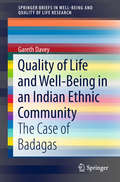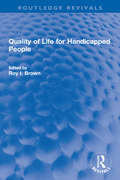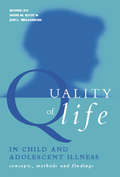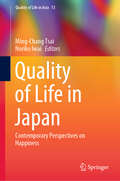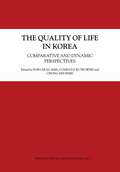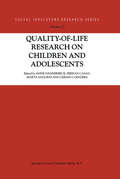- Table View
- List View
The Quality of European Societies: A Compilation of Composite Indicators (Social Indicators Research Series #75)
by Eduardo Bericat María Luisa Jiménez-RodrigoThis volume presents a compilation of composite indicators created in order to measure important aspects of the quality of European societies. It examines three main questions: do Europeans live in good societies and enjoy good lives; are European societies becoming better as time passes, or is their quality slowly deteriorating; is the quality of life of Europe’s citizens improving over time or is it gradually and irrecoverably getting worse. The volume uses a precise and rigorous system of information to answer these questions and to assess the current situation and monitor the quality of European societies. It describes and discusses fourteen key domains, and per chapter, presents five rankings of EU countries based on composite indicators, which are used as one of the best instruments social science has to synthesize a large amount of information, and they are especially well suited to measure multidimensional social phenomena. The new System of Indices on the Quality of European Societies (SIQES) presented in this volume offers a very broad and rich empirical overview of more than 70 social composite indicators and their nearly 300 dimensions. One of the key findings coming out from the SIQES is that, according to the societal quality of European countries, there exist five different “Europes” inside Europe.
Quality of Life Among Cancer Survivors: Challenges and Strategies for Oncology Professionals and Researchers
by Tanya R. FitzpatrickThis multidisciplinary reference explores the concepts and realities of quality of life among cancer survivors in its physical, psychological, cognitive, social, and familial dimensions. Informed by a broad range of fields including genetics, psychiatry, nursing, dentistry, rehabilitation, and ethics, it addresses daily challenges of living for this population, from self-care to cultural concerns and from social interactions to experiences with providers. Family issues of pediatric, young adult, and elder survivors, caregiving parents, and siblings are a major area of concern. And contributors describe interventions for survivors as individuals, in family content, and as part of integrated care across primary and specialty settings. Included among the topics: Play, leisure activities, and cognitive health among older cancer survivors. Genetic mutations in cancer susceptibility genes: a family history of cancer. Cancer patients in a pediatric intensive care unit: a single center experience. The impact of childhood cancer on the quality of life among healthy siblings. When cancer returns: family caregivers and the hospice team. Experiencing cancer services: a story of survival and dissatisfaction. A significant addition to the cancer survivorship literature, Quality of Life Among Cancer Survivors is a practice-building resource for oncology and allied health professionals, health psychologists, and social workers, as well as researchers in these fields.
Quality of Life and Daily Travel (Applying Quality of Life Research)
by Margareta Friman Dick Ettema Lars E. OlssonThis volume analyses the relevance of daily travel in the quality of life of individuals. It provides a broad understanding of the links between life satisfaction, well-being and travel, the importance of commuting, and different evaluations and measures to assess the experience of commuting and quality of life. Chapters in this book relate travel and quality of life to the built environment, accessibility and exclusion, travel mode choice, travel satisfaction and emotions. It brings together distinguished researchers from a variety of academic backgrounds providing conceptualizations and applications, presented as case studies, for daily travel and well-being. Findings presented in this book are highly relevant for transport planners, transport marketers, public transport authorities, and environmental professionals in the pursuit of improving people’s life.
Quality of Life and Mental Health Services
by Peter Huxley Dr Peter Huxley Keith Bridges Hadi Mohamad Joseph OliverThis book is about the lives of patients, about the health and social care services provided to help them, and about ways of examining the impact these services make on them. Based on the authors' experience of using and developing a particular operational measure, the Lancashire Quality of Life Profile, which has been used successfully in many different studies and countries, it provides managers and practitioners in mental health with valuable normative data, insights and ideas about the role of QOL in service evaluation.
Quality of Life and Mental Health Services
by Peter Huxley Dr Peter Huxley Keith Bridges Hadi Mohamad Joseph OliverThis book is about the lives of patients, about the health and social care services provided to help them, and about ways of examining the impact these services make on them. Based on the authors' experience of using and developing a particular operational measure, the Lancashire Quality of Life Profile, which has been used successfully in many different studies and countries, it provides managers and practitioners in mental health with valuable normative data, insights and ideas about the role of QOL in service evaluation.
Quality of Life and Mortality Among Children: Historical Perspectives (SpringerBriefs in Well-Being and Quality of Life Research)
by Thomas E. JordanThis birefs examines mortality among young children in the period from the seventeenth to the nineteenth century. It does so using several types and sources of information from the census unit England and Wales, and from Ireland. The sources of information used in this study include memoirs, diaries, poems, church records and numerical accounts. They offer descriptions of the quality of life and child mortality over the three centuries under study. Additional sources for the nineteenth century are two census-derived numerical indexes of the quality of life. They are the VICQUAL index for England and Wales, and the QUALEIRE index for Ireland. Statistical procedures have been applied to the numbers provided by the sources with the aim to identify effects of and associations between such variables as gender, age, and social background. The briefs examines the results to consider the impact of children’s deaths upon parents and families, and concludes that there are differences and continuities across the centuries.
Quality of Life and Mortality in Seventeenth Century London and Dublin (SpringerBriefs in Well-Being and Quality of Life Research)
by Thomas E. JordanThis book provides an examination of the quantitative and qualitative factors affecting mortality in two major cities of the British Isles: London and Dublin. It covers a scale from individuals mentioned by name to aggregates of mortality data in the Bills of Mortality. Focusing on the Seventeenth Century, the book pays attention to the Great Plague of 1665, and to earlier years in which epidemics decimated populations.To the average person living in the seventeenth century, life was a series of challenges. Mortality among the young was high, and for those who survived early childhood, death in their fifties was fairly typical. Men and women might aspire to a longer life span, but even the healthiest practices were no guarantee when the overall quality of life was low. With fatal illnesses exemplified by typhoid fever on the one hand, and the arrival of yersinia pestis – plague through ports on the Mediterranean at regular intervals of several years, on the other, mortality became a foreseeable event.
Quality of Life and Psychosomatics: In Mechanical Circulation • The Heart Transplantation
by W. Albert, A. Bittner and R. HetzerAdvances in heart surgical treatment have been impressive in the last 15 years. In end-stage heart disease, procedures are now performed routinely which were only experimental one or two decades ago. Heart transplantation has become a well-established procedure. According to the Gen eral Registry of the International Society of Heart and Lung Transplantation. 40,738 heart transplantations had been performed through the end of 1997 with survival rates of 78 % at one year, 65 % at five years, and 42 % at ten years. The progress in this field has been due to intense efforts in understanding and modulating immune responses to the trans planted heart, to elaborate therapeutic strategies to constrain infections, and to improved out-patient care. Accordingly, heart transplantation is integrated into the facilities of the health care systems, the routine of physicians, and the awareness of patients. The resulting increase in potential organ recipients has not been met, however, by an equivalent increase of available donor organs. This increasing discrepancy has forced the technical improvement and clinical evalua tion of mechanical circulatory support systems as an option for treatment of critically ill patients with a failing heart. Initially, these assist devices were only used to maintain sufficient circulation in post-cardiotomy heart failure until myocardial function had recov ered. Since the late 1980s, their primary use has been that of bridging patients with heart failure until a suitable organ is available so that heart transplantation can be performed.
Quality of Life and Well-Being in an Indian Ethnic Community: The Case of Badagas (SpringerBriefs in Well-Being and Quality of Life Research)
by Gareth DaveyThis book explores the quality of life among Badagas, an ethnic minority group in South India, as they navigate a society in flux, with specific reference to rural-to-urban migration and new media. At an empirical level, it reveals how Badagas understand themselves and the multifaceted changes in their culture and daily lives, exploring a pertinent concern at the forefront of debate about the future from a global perspective. The book draws attention to the fact that people are adopting flexible identities and lifestyles in an attempt to survive and thrive in a changing India and world, a new ‘Indian-ness’ shaped at the local level. It offers a timely update on previous research on Badagas, which dates to the 1990s, and also serves as an important case study on people’s experiences of the social and economic transformation of Indian society as they become accustomed to new ideas, products, and ways of life. As such, it is a must-read for all those interested in quality of life in India and developing societies.
Quality of Life, Environmental Changes and Subjectivity: A Contribution to a New Line of Research on Climate Change
by Sônia Regina da Cal Seixas João Luiz de Moraes HoefelIn this volume, the authors consider how environmental changes affect our social, cultural and political lives and, in doing so, have a direct influence on individuals’ health. In contrast to previous research in the area, da Cal Seixas and de Moraes Hoefel emphasize both physical health and mental health as measures of human suffering, in an approach informed by the concept of subjectivity. Ultimately, the authors argue that contemporary environmental changes have a significant effect on the mental and physical wellbeing of the world’s population, and that analysis and proposals for action should address both concerns in an effort to improve our quality of life.
Quality of Life for Handicapped People (Routledge Revivals)
by Roy I. BrownFirst published in 1988, Quality of Life for Handicapped People examines developments and innovations in research and practice concerning the quality of life for those with disabilities. The book centres on the topic of rehabilitation education, with a particular focus on issues relating to quality of life, including what is meant by ‘quality of life’ and the measures and systems required to assess the variables involved. It highlights the significance of rehabilitation education in underlining the key issue of how individuals feel about themselves and how they perceive the services available to them for the purpose of rehabilitation. It considers the importance of environment and the improvement of environment in increasing quality of life, and examines a range of vocational and social programmes from a variety of perspectives. Quality of Life for Handicapped People will be of use to those with an interest in the history and development of rehabilitation education.
Quality of Life for Handicapped People (Routledge Revivals)
by Roy I. BrownFirst published in 1988, Quality of Life for Handicapped People examines developments and innovations in research and practice concerning the quality of life for those with disabilities. The book centres on the topic of rehabilitation education, with a particular focus on issues relating to quality of life, including what is meant by ‘quality of life’ and the measures and systems required to assess the variables involved. It highlights the significance of rehabilitation education in underlining the key issue of how individuals feel about themselves and how they perceive the services available to them for the purpose of rehabilitation. It considers the importance of environment and the improvement of environment in increasing quality of life, and examines a range of vocational and social programmes from a variety of perspectives. Quality of Life for Handicapped People will be of use to those with an interest in the history and development of rehabilitation education.
Quality of Life Impairment in Schizophrenia, Mood and Anxiety Disorders: New Perspectives on Research and Treatment
by A. George AwadA fascinating and worthy text that presents new insights into a hugely important area of mental health. Health-related quality of life (HRQL) impairment is a core domain of prevalent mental disorders such as schizophrenia, schizoaffective, mood and anxiety disorders. The authors present a new conceptual framework for this field by explaining how HRQL impairment arises from interactions between various multidimensional factors. They suggest several ways in which further research could enhance our understanding of HRQL impairment, its biological basis, and its relevance to psychopathology.
Quality of Life in Behavioral Medicine Research (Perspectives on Behavioral Medicine Series)
by Joel E. Dimsdale Andrew BaumThe number of, and interest in, quality of life studies has grown dramatically in the last decade. On an ever increasing basis, patients, clinicians, researchers, and health policy regulators are considering quality of life in assessing treatment alternatives. Unfortunately, most discussions of quality of life are narrow in scope -- applying to only one disease group. This unique book represents the concerted effort of experts in academia, federal government health care regulators, and pharmaceutical industry representatives to define the promise and the problems associated with quality of life studies. The issues covered range from cross cutting ones to those that are specific to particular illnesses. Because quality of life takes into consideration such domains as mood, vocation, family, sexual functioning, social participation, and costs, this book will serve as an invaluable companion to readers with an interest in behavioral medicine research.
Quality of Life in Behavioral Medicine Research (Perspectives on Behavioral Medicine Series)
by Joel E. Dimsdale Andrew S. BaumThe number of, and interest in, quality of life studies has grown dramatically in the last decade. On an ever increasing basis, patients, clinicians, researchers, and health policy regulators are considering quality of life in assessing treatment alternatives. Unfortunately, most discussions of quality of life are narrow in scope -- applying to only one disease group. This unique book represents the concerted effort of experts in academia, federal government health care regulators, and pharmaceutical industry representatives to define the promise and the problems associated with quality of life studies. The issues covered range from cross cutting ones to those that are specific to particular illnesses. Because quality of life takes into consideration such domains as mood, vocation, family, sexual functioning, social participation, and costs, this book will serve as an invaluable companion to readers with an interest in behavioral medicine research.
Quality of Life in Child and Adolescent Illness: Concepts, Methods and Findings
by Hans M. Koot Jan L. WallanderHow can we measure the quality of life in children and adolescents with chronic disease? Major progress in the diagnosis and treatment of severe and chronic disease has led to an increased number of children and their families having to adapt and cope with the impact of disease, survival, and the cost of treatment. Health professionals have responded to this by developing a diversity of instruments for measuring quality of life for use in paediatrics, psychology and public health. This book introduces the reader to the emerging field of quality of life assessment and provides a comprehensive overview of the conceptual and methodological issues concerning quality of life in child and adolescent illness. Particular emphasis is provided on current efforts to measure the impact of specific chronic conditions on different domains of child functioning. Future directions are outlined for the development of appropriate instruments for measuring quality of life in children and adolescents. Quality of Life in Child and Adolescent Illness is intended for psychologists, paediatricians, paediatric nurses, child psychiatrists, public health professionals, researchers and other interested readers from the undergraduate to the working professional.
Quality of Life in Child and Adolescent Illness: Concepts, Methods and Findings
by Hans Koot Jan WallanderHow can we measure the quality of life in children and adolescents with chronic disease? Major progress in the diagnosis and treatment of severe and chronic disease has led to an increased number of children and their families having to adapt and cope with the impact of disease, survival, and the cost of treatment. Health professionals have responded to this by developing a diversity of instruments for measuring quality of life for use in paediatrics, psychology and public health. This book introduces the reader to the emerging field of quality of life assessment and provides a comprehensive overview of the conceptual and methodological issues concerning quality of life in child and adolescent illness. Particular emphasis is provided on current efforts to measure the impact of specific chronic conditions on different domains of child functioning. Future directions are outlined for the development of appropriate instruments for measuring quality of life in children and adolescents. Quality of Life in Child and Adolescent Illness is intended for psychologists, paediatricians, paediatric nurses, child psychiatrists, public health professionals, researchers and other interested readers from the undergraduate to the working professional.
Quality of Life in Epilepsy: Beyond Seizure Counts in Assessment and Treatment
by Gus A. Baker Ann JacobyThough clinical aspects of epilepsy such as seizure control are crucially important to its management, increasing attention is being given to wider quality of life issues. Epilepsy continues to be an often misunderstood and stigmatising condition; for the vast majority of people whose seizures can be well controlled, the social and psychological repercussions are often of greater significance than the seizures themselves.The increasing emphasis on the importance of non-clinical outcomes in the assessment of new treatments and management strategies for chronic conditions such as epilepsy has stimulated interest in methodological issues in assessing quality of life. This book reviews the recent literature on the impact of epilepsy on everyday experience and the methodological issues involved in assessing that impact. It also considers the perspectives of a range of health professionals involved in caring for people with epilepsy and how, through appropriate management, the impact on their lives can be minimised.
Quality of Life in Epilepsy: Beyond Seizure Counts in Assessment and Treatment
by Gus A. Baker Ann JacobyThough clinical aspects of epilepsy such as seizure control are crucially important to its management, increasing attention is being given to wider quality of life issues. Epilepsy continues to be an often misunderstood and stigmatising condition; for the vast majority of people whose seizures can be well controlled, the social and psychological repercussions are often of greater significance than the seizures themselves.The increasing emphasis on the importance of non-clinical outcomes in the assessment of new treatments and management strategies for chronic conditions such as epilepsy has stimulated interest in methodological issues in assessing quality of life. This book reviews the recent literature on the impact of epilepsy on everyday experience and the methodological issues involved in assessing that impact. It also considers the perspectives of a range of health professionals involved in caring for people with epilepsy and how, through appropriate management, the impact on their lives can be minimised.
Quality of Life in Japan: Contemporary Perspectives on Happiness (Quality of Life in Asia #13)
by Ming-Chang Tsai Noriko IwaiThis edited volume approaches the life experiences and well-being of Japanese people from an empirical perspective. It explores the current trend of happiness among Japanese over time and examines the association of income, lifestyle, and perceived life conditions using modern econometric models with supplementary qualitative observations. Issues relating to ageing, gender, household division of labour, and emigration are also examined to provide a wide scope of results based on both survey and field methods for culturally sensitive researchers. Going beyond the conventional cultural interpretation of the uniqueness of the Japanese case, this book provides timely, empirical evidence for understanding how the various social groups comprising the Japanese population have enjoyed a better quality of life, while some groups are very dissatisfied with social arrangements and have elected to emigrate. The book is a pioneering endeavour to reveal the detailed structure of quality of life and well-being in Japanese society.
The Quality of Life in Korea: Comparative and Dynamic Perspectives (Social Indicators Research Series #14)
by Doh Chull Doh Chull Shin Conrad P. Rutkowski Chong-Min Chong-Min ParkThis is the first volume ever published to examine the objective and subjective qualities of Korean life from both comparative and dynamic perspectives. It presents non-Western policy alternatives to enhancing the quality of citizens' lives, distinguishing Korea as an Asian model of economic prosperity and political democracy. It is intended for academics and policymakers interested in recent developments in Korea.
Quality-of-Life Research on Children and Adolescents (Social Indicators Research Series #23)
by Anne Dannerbeck Ferran Casas Marta Sadurni Germa CoendersThis title is a must-read for anyone interested in deepening their understanding of the behaviours of children and adolescents. It focuses on measurement issues related to the subjective well-being of children and adolescents as opposed to current objective measurements. The volume contains eight chapters that represent a significant advancement in our understanding of life satisfaction in specific age groups, behavioural context, and cultures. The first chapter provides a synthesis of assessment research directed at children and youth. The subsequent chapters offer an in-depth look at subpopulations of youth and specific behaviours. Together the chapters demonstrate the importance of considering the role of life satisfaction across age groups and situations. This volume will be of interest to researchers in government and academia, social psychologists, those working in the prevention sciences, and others who focus on assessing the quality of life and well-being of children and adolescents.
Quality of Life Therapy: Applying a Life Satisfaction Approach to Positive Psychology and Cognitive Therapy
by Michael B. FrischNote: Book no longer includes a CD-ROM, but the files are available online for download for both book and ebook purchasers at www.wiley.com/go/frisch "This book defines an approach to well-being and positive psychology, that is state-of-the-art, evidence-based, empirically validated, and an outstanding guide for anyone interested in learning about the practice of positive psychology or well-being." —Ed Diener, the world authority on happiness from the University of Illinois and President of the International Positive Psychology Association. Endorsed by Christopher Peterson of the University of Michigan and taught in Marty Seligman's Masters in Applied Positive Psychology (MAPP) Program at the University of Pennsylvania, this book teaches a simple, step-by-step method for putting the fields of well-being and positive psychology into practice. It is a "one-stop shopping" manual with everything you need in one book and with one approach. This approach to greater happiness, meaning, and success is “evidence-based” and empirically validated. It has been successfully tested in three randomized controlled trials, including two NIH-grant funded trials conducted by James R. Rodrigue and his colleagues at Beth Israel and Harvard Medical Centers in Boston. Quality of Life Therapy also known as Quality of Life Therapy and Coaching or QOLTC is designed for use by therapists, coaches, organizational change-agents/consultants, and all professionals who work to improve peoples' well-being. Many laypersons and clients have found the book useful as well. This book explains the "Sweet 16" Recipe for Joy and Success, along with validated interventions for each: 1. Basic Needs or Wealths: Health, Money, Goals-and-Values/Spiritual Life, Self-Esteem 2. Relationships: Love, Friends, Relatives, and Children 3. Occupations-Avocations: Work and Retirement Pursuits, Play, Helping-Service, Learning, Creativity 4. Surroundings: Home, Neighborhood, Community
Quality Teaching in Primary Science Education: Cross-cultural Perspectives
by Mark W. Hackling Jörg Ramseger Hsiao-Lan Sharon ChenThis edited volume explores how primary school teachers create rich opportunities for science learning, higher order thinking and reasoning, and how the teaching of science in Australia, Germany and Taiwan is culturally framed. It draws from the international and cross-cultural science education study EQUALPRIME: Exploring quality primary education in different cultures: A cross-national study of teaching and learning in primary science classrooms. Video cases of Year 4 science teaching were gathered by research teams based at Edith Cowan University, Deakin University, the Freie Universität Berlin, the National Taiwan Normal University and the National Taipei University of Education. Meetings of these research teams over a five year period at which data were shared, analysed and interpreted have revealed significant new insights into the social and cultural framing of primary science teaching, the complexities of conducting cross-cultural video-based research studies, and the strategies and semiotic resources employed by teachers to engage students in reasoning and meaning making. The book’s purpose is to disseminate the new insights into quality science teaching and how it is framed in different cultures; methodological advancements in the field of video-based classroom research in cross-cultural settings; and, implications for practice, teacher education and research.“The chapters (of this book) address issues of contemporary relevance and theoretical significance: embodiment, discursive moves, the social unit of learning and instruction, inquiry, and reasoning through representations. Through all of these, the EQUALPRIME team manages to connect the multiple cultural perspectives that characterise this research study. The ‘meta-reflection’ chapters offer a different form of connection, linking cultural and theoretical perspectives on reasoning, quality teaching and video-based research methodologies. The final two chapters offer connective links to implications for practice in teacher education and in cross-cultural comparative research into teaching and learning. These multiple and extensive connections constitute one of the books most significant accomplishments.The EQUALPRIME project, as reported in this book, provides an important empirical base that must be considered by any system seeking to promote sophisticated science learning and instructional practices in primary school classrooms. By exploring the classroom realisation of aspirational science pedagogies, the EQUALPRIME project also speaks to those involved in teacher education and to teachers. I commend this book to the reader. It offers important insights, together with a model of effective, collegial, collaborative inter-cultural research. It will help us to move forward in important ways”.Professor David Clarke, Melbourne University
Quality Work in Higher Education: Organisational and Pedagogical Dimensions (Higher Education Dynamics #54)
by Mari Elken Peter Maassen Monika Nerland Tine S. Prøitz Bjørn Stensaker Agnete VabøThis book focuses on quality work in higher education, and examines the relationship between the organizational and pedagogical dimensions of quality work in higher education. Bringing together different disciplinary traditions, including educational science, sociology, and organisational studies, it addresses the following principal research question: How is quality work carried out in higher education?The book addresses a wide variety of academic, administrative and leadership practices that are involved in quality work in higher education institutions. The chapters in this book examine core issues crucial in the design and content of study programs, such as modes of teaching, learning and curricula design, as well as institutional practices regarding assessment and quality enhancement. The introductory and concluding chapter present an overarching focus on quality work as a lens to analyse intentional activities within higher education institutions directed at how study programmes and courses are designed, governed, and operated.







